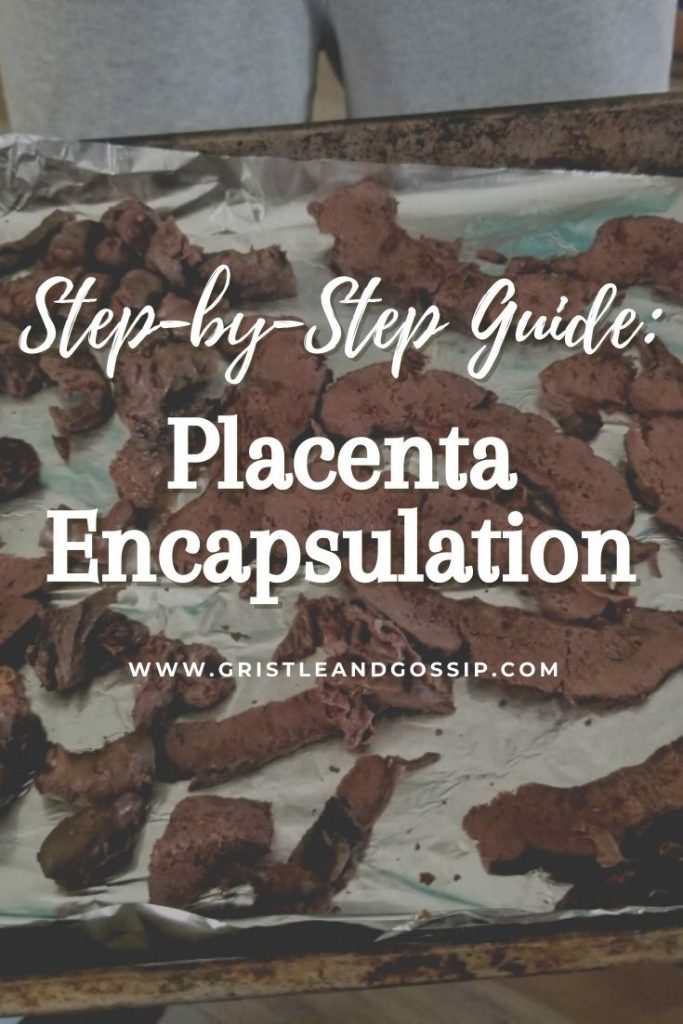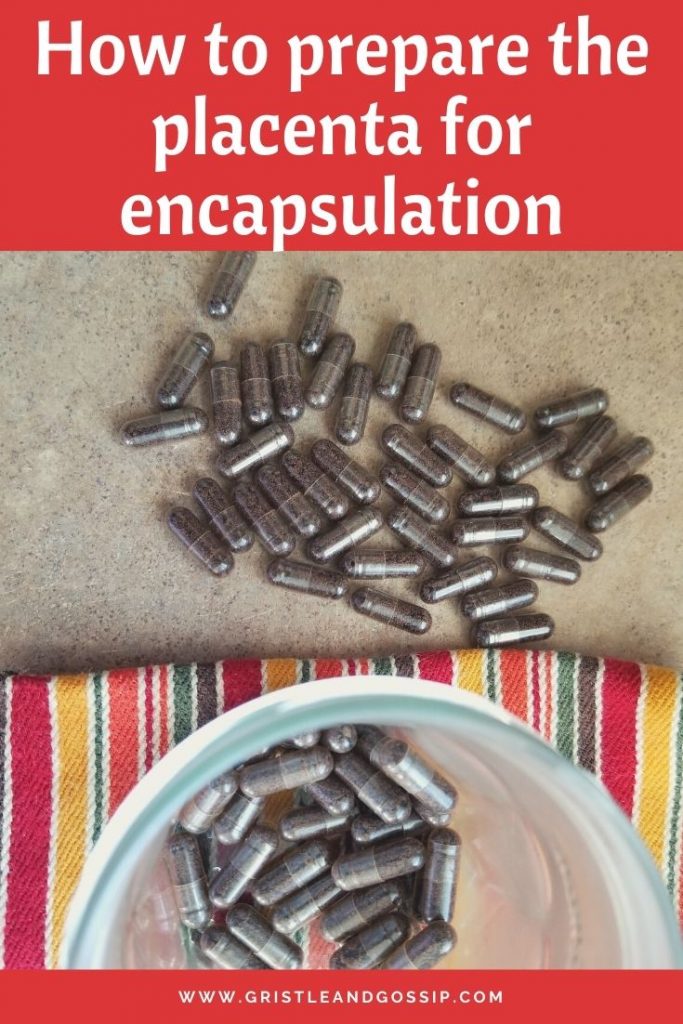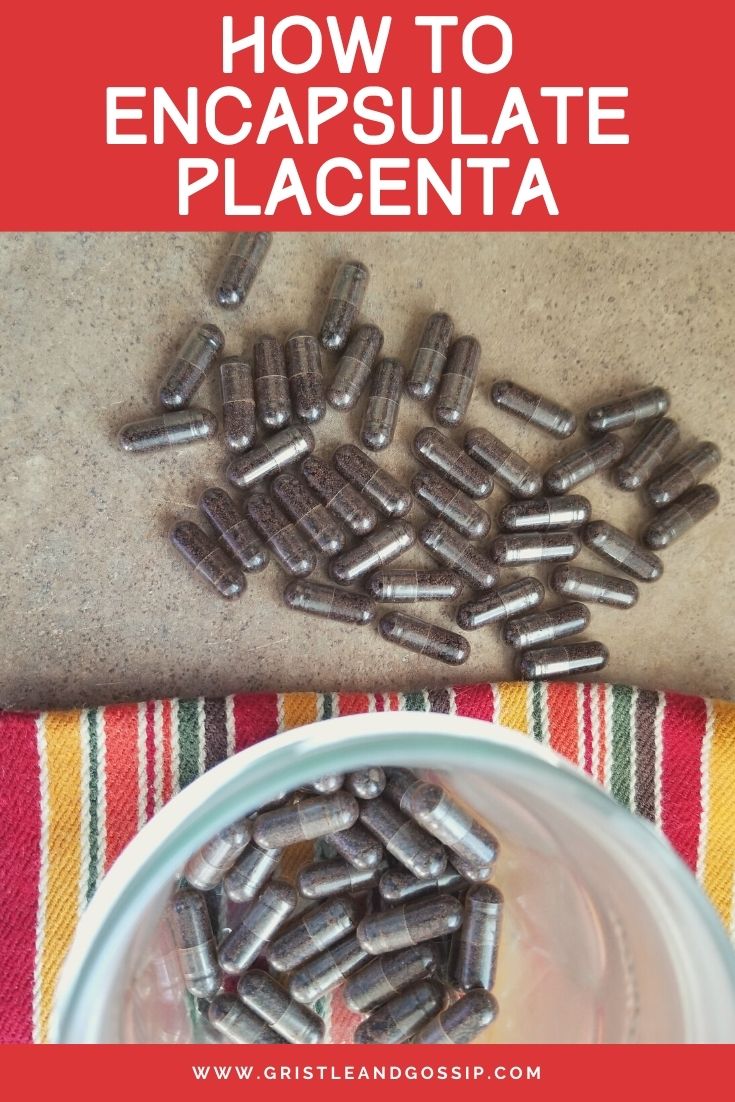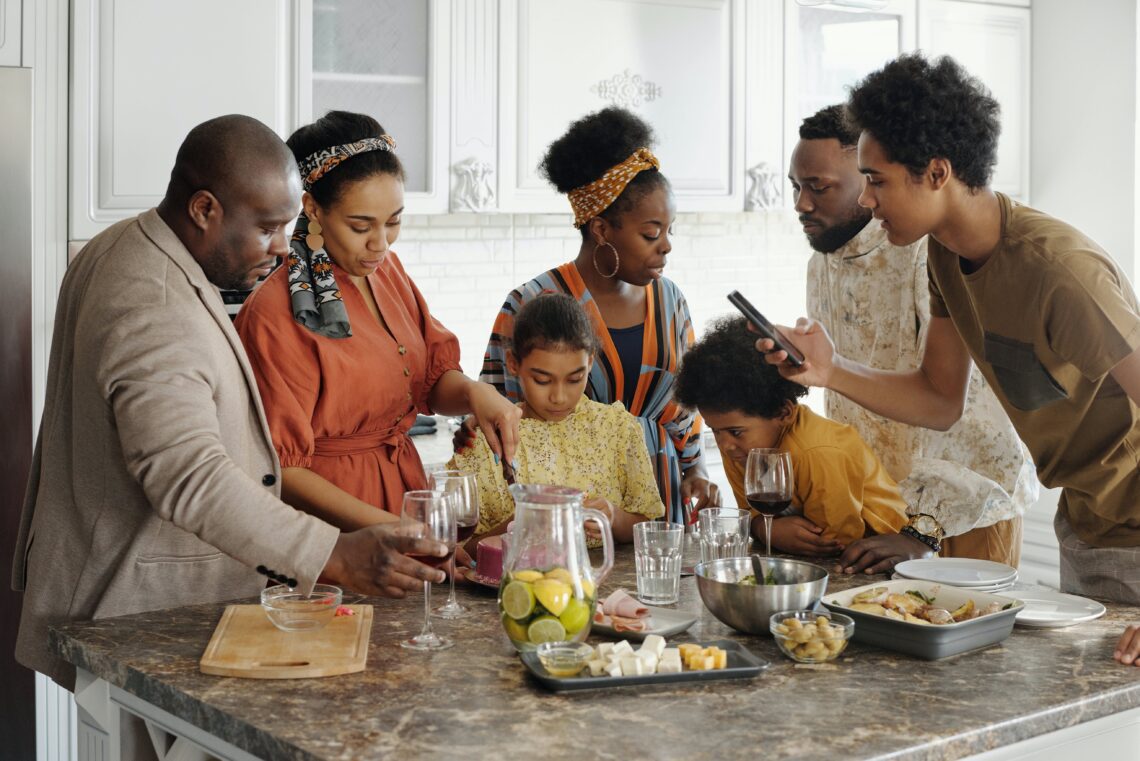DIY placenta encapsulation is not a difficult as you may think. This tutorial covers How to encapsulate your placenta, my personal choices regarding an alternative solution to common postpartum complaints, and other important details to ensure your placenta arrives home safe.
PIN THIS POST

I am not a doctor. As a matter of fact, I am probably the farthest thing from a doctor. This post is specifically about my personal choices regarding an alternative solution to common postpartum complaints and why following the birth of my daughter, I decided placenta encapsulation was right for me.
Prior to the birth of our child, my husband and I researched natural remedies to common postpartum complaints. Although there are many articles out there that frown at Placentophagy, its positive effects outweighed the negative for me.
If you’re considering encapsulating your placenta, it’s important that you do your research. Making the best choices for you and your baby are truly the most essential elements to postpartum recovery.
WHAT IS PLACENTA?
The placenta organ plays a vital role in your baby’s development. A healthy placenta absorbs nutrients, eliminates waste and gas exchange via the mother’s blood supply. It aids in fighting against internal infection and produces hormones that support pregnancy.
The placenta contains oxytocin, a hormone that reduces pain and increases bonding with the baby. It also contains thyroid stimulating hormones, interferon, and prolactin, which can boost the immune system, energy, recovery, and milk supply.
PLACENTA ENCAPSULATION vs. PRESCRIPTION DRUGS
Placentopahy is the ingestion of a human placenta postpartum, at any time, by any person, either in raw or altered (e.g., cooked, dried, steeped in liquid) form. Eating placenta is huge in China and is becoming a trend here in the states. To me, it’s a sign that people are becoming more conscious of what they’re putting in their bodies. People are realizing that prescription drugs are more about money, rather than actually fixing a problem.
I knew before my daughter was born that she would be EBF (exclusively breastfed). This basically means from birth to around six months she will only consume my breast milk. Breastfeeding a hungry two-month-old is no simple task. It’s important that my milk supply withstand her growth spurts and keep her satiated. So instead of ingesting galactagogues herbs like fenugreek and fennel, I decided to eat my placenta.
CAN YOU TAKE YOUR PLACENTA HOME?
The first step towards encapsulation is actually getting your placenta home. Hospitals label placenta as a “biohazardous material,” that should be discarded immediately after birth. If this is the case how is it found in makeup? Somebody is taking YOUR placenta and selling it to these major companies, without your consent!
Luckily my OBGYN was pretty cool about it and was actually knowledgeable about the process. We communicated our wishes every step of the way and during our post-op, she provided us with the information we needed to safely get our placenta home.
WHAT DO I NEED TO SAFELY TRANSPORT MY PLACENTA FROM THE HOSPITAL?
We were told to bring a cooler, a small ice pack, and a zip-lock bag into the delivery room. As soon as our daughter was born and we were both resting comfortably, my husband immediately took the placenta home and stored it in the freezer. It’s vital that the organ be kept frozen until you’re ready to use it. The optimal time to process a placenta is within 3-5 days.
CAN YOU ENCAPSULATE YOUR OWN PLACENTA?
Yes! My sweet husband did all the research and all the work. From the best capsules to purchase to the best method of consumption. I do not recommend sending your placenta to some random company to have it encapsulated. Do it yourself. If you can’t do it yourself at least provide the instructions to someone that you trust, and have them do it. You want your placenta to be treated with care, in a sanitary environment. Remember that anything you ingest goes to your baby if you’re breastfeeding and/or pumping.
We decided to steam and dehydrate my placenta. Given that I take two pills a day, the capsule itself was important to us as well. We settled on Capsuline K-CAPS® Vegetarian Capsules. One of the few capsules we found that were made with 100% plant-derived material and purified water.



HOW DO I DRY OUT MY PLACENTA?
Steaming and dehydrating the placenta is the method we took to dry out my placenta. Per my husband, steaming and dehydrating my placenta was pretty easy. The steaming helps purge any harmful bacteria from the placenta. Dehydrating your placenta removes all liquid and prepares it to be ground into a fine powder pre-encapsulation.
WHAT YOU WILL NEED TO DRY PLACENTA:
Equipment
- Medium-sized pot with a steamer basket
- Sharp knife
- Wooden cutting board
- Aluminum baking sheet
- Allergen-free latex gloves
Ingredients for steaming
- Lemons
- Fresh Ginger
HOW TO STEAM AND DEHYDRATE PLACENTA?
We used our oven, but I have read other posts where a dehydrator was used. Additionally, we followed the Traditional Chinese Method for placenta encapsulation, the lemons are astringent, while the ginger warms the blood helping to move things along in the bloodstream. Remember that If you don’t use any of them, you are still going to get the benefits of your placenta but these added ingredients are definitely helpful.
- Preheat oven to 225º degrees F
- Remove placenta from the freezer and allow it to completely thaw in the fridge (as you would any frozen meat).
- Once thawed, place placenta inside steamer pot, with chopped lemons, and fresh-cut ginger.
- Steam the placenta for 20 minutes. Remove from steamer and rest on a parchment paper-lined cutting board.
- Cut Placenta into small 1/4 inch strips and place on a foil-lined baking sheet.
- Bake at 225º (stove door ajar) for 8 hours.
- Add the dehydrated pieces to a mini chopper and pulse the placenta into finely grounded powder.
- Following this process, rinse your mini chopper with vinegar to remove all remaining placenta from the blade.
- Add placenta powder to capsules and store in a glass jar in the fridge.
Your home will smell like you are cooking a roast. My hubby did this while I was asleep, so I woke up thinking he was cooking dinner. Only realize he was cooking a part of me!
HOW OFTEN DO YOU TAKE PLACENTA PILLS?
I take two pills a day. One with breakfast and the other with dinner. In my opinion having a little food on your stomach helps the pill absorb. This worked for me, but you may find that you need to increase your dose. Some women consume one or two capsules three times a day during the first couple of weeks post-partum or until they feel their hormones have returned to normal.
HOW LONG IS PLACENTA GOOD FOR?
At the conclusion of the placenta encapsulation process, I was left with a 90-day supply (180 capsules) of capsules. Enough to get me over the post-partum hump. As I reflect back on this process I don’t recall suffering from many post-partum symptoms. With the exception of post-partum hair loss. Read more about my tips for combating post-partum hair loss here.
I hope you find this DIY placenta encapsulation post helpful. This would not have been possible without the support of my loving husband, who did all of the work. Our goal was to ensure that we took this part of our journey into our own hands. We are very hands-on parents who refuse to take “no” for an answer. If you are interested in learning more about placenta encapsulation drop me a comment. The questions I can answer I will. Make sure to take with your doctor about your options as well. As, always feel free to connect with me on INSTAGRAM, FACEBOOK, and PINTEREST.
LOVE IT? PIN IT!













